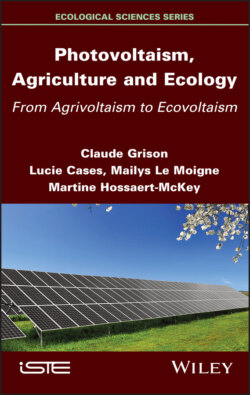Читать книгу Photovoltaism, Agriculture and Ecology - Martine Hossaert-McKey - Страница 5
Оглавление
Foreword by Yvon Le Maho
This update by Claude Grison, Lucie Cases, Mailys Le Moigne and Martine Hossaert-McKey on how the development of a renewable energy, photovoltaics, could be part of a real ecological transition meets a real need.
Indeed, in view of the two major environmental issues of our time – the fight against climate change and the reduction of biodiversity – we are faced with what appears to be an abuse of language that hides a real divide. What is it about? In the dominant discourse, climate change is associated with an “ecological catastrophe”. Certainly, according to the most probable scenarios, the announced global warming will eventually result in a significant loss of biodiversity. To avoid such an outcome, this implies that we must fight against climate change.
In fact, the seriousness of this prognosis is largely linked to the fact that climate change will weigh on an already weakened biodiversity. For most of the reduction in biodiversity already observed, more than 80% of the decrease in populations of threatened species, according to a recent WWF study, has nothing to do with climate change. Land artificialization, overexploitation of resources, intensive farming and disturbance are the main causes. It is therefore two parallel actions, both fighting against the human factors of climate change, that is, against the increase of greenhouse gases, and recovering biodiversity, that must be carried out. The indicators of the better health of fauna that followed the recent period of confinement caused by the COVID-19 health crisis have shown something important: the reduction of the disturbance induced by humans towards the animal populations during their period of reproduction has already shown very positive effects… However, the stakes of the fight against the reduction of biodiversity are not only patrimonial but also economic. The crucial importance of pollinating insects is enough to remind us of this.
In addition, there is a divide between scientific and technological research that is moving forward and an ecology that can easily be derided as a movement promoting a return to the past. It is only a softened form of the parable in which he who wants to get rid of his dog cries out that he has rabies… It is true that the indistinguishability in terms between a militant and political ecology and scientific ecology does not make things easier. But this dichotomy between research that is synonymous with progress and an ecology that would be a brake on it can be found right up to the ministerial level in the main European countries. It is even the main obstacle to the development of expertise on biodiversity, as we noted with Julien Boucher, Maître des requêtes1 at the Conseil d’État (Council of State), in a report we wrote commissioned by the then Minister of the Environment, Jean-Louis Borloo, and the Secretary of State, Chantal Jouanno, a report that we submitted to Nathalie Kosciusko-Morizet, who succeeded Borloo as Minister of Ecology.
It is therefore in more than one way that the book by Claude Grison and her colleagues meets a real need. As these authors clearly show, scientific and technological developments and advances in engineering must not be carried out separately to meet the challenges of climate and biodiversity. Optimization must be sought through an approach that can only be multidisciplinary and interdisciplinary in order to reconcile the development of photovoltaics with the need to save water reserves and halt the decline in animal and plant biodiversity. In order to promote this multidisciplinary and interdisciplinary approach, the authors of this book obviously had many assets at their disposal. They are breaking down the barriers of science at the interface between chemistry and ecology, an approach that they consider indispensable to the ecological transition. Claude Grison serves as a Director of Research at the CNRS (French National Center for Scientific Research) and leads the Bio-inspired Chemistry and Ecological Innovations Laboratory, a laboratory that brings together chemists and ecologists around common themes. She has associated two students from the laboratory, Lucie Cases and Mailys Le Moigne, who share her passion for the search for ecological and innovative solutions in the production of new energy. Through her expertise in chemical ecology, Martine Hossaert-McKey, Emeritus Director of Research at the CNRS in charge of biodiversity, makes the link between the plant and insect worlds by studying how chemical language shapes these interactions and structures ecosystems. The authors of this book have taken great care to show not only the advantages but also the limitations of the different techniques implemented in agrivoltaics and ecovoltaics. The aim of this book is therefore not to dangle unrealistic objectives but, by showing the avenues currently being explored around photovoltaics, to encourage the reader to reflect on the even more general prospects offered by multidisciplinary engineering that could respond to both climate and biodiversity issues.
Yvon LE MAHO
CNRS Emeritus Research Director
Institut pluridisciplinaire Hubert-Curien University of Strasbourg and Scientific Center of Monaco Member of the Académie des sciences Associate Member of the Académie nationale de pharmacie
1 1 Master of Requests, i.e. a high judicial officer of administrative law in France.
